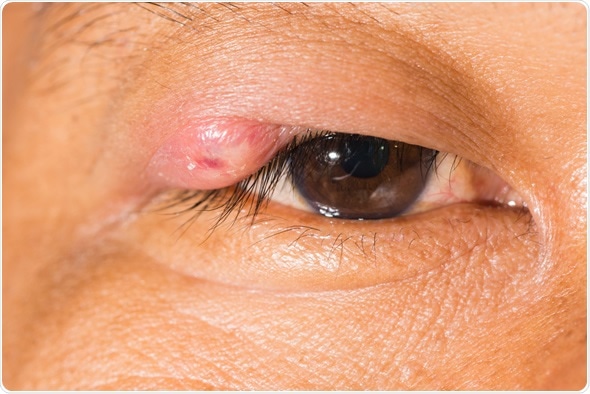A stye or sty, also known as a hordeolum, is a small, painful red lump that develops on the inside or outside of an eyelid. It is caused by a bacterial infection that can develop inside the root follicle of an eyelash, inside the apocrine gland or within the sebaceous gland attached to the follicle. The stye takes only a few days to develop.
The stye is an acute abscess which creates a lump that appears to have a yellow point in the middle. It is filled with pus. The condition is most often caused by staphylococcal bacteria, which is a common commensal in our bodies. It causes infection only when it gains entry into the body through a disrupted epithelium. The bacteria can spread quite easily from the nose, where it is usually located, to the eye to cause a stye.
Styes may develop in both children and adults. The presence of eyelid inflammation, or blepharitis, predisposes to the formation of a stye.

Risk factors
Styes occur more commonly in conditions which cause blepharitis, such as ocular rosacea, diabetes which predisposes to bacterial infections, and seborrheic dermatitis. The use of old or expired makeup, and the practice of sharing cosmetics, may also increase the chances of developing a stye.
Symptoms of a stye
A patient with a stye may complain of:
- A small painful lump on the eyelid
- Watering of the eye
- Inability to tolerate light
- Redness of the eyelid
- Sometimes, redness of the eye
- A feeling that grit has got into the eye
Sometimes there may be more than one stye on an eye, or styes on both eyes. This is less common, however.
Complications of a stye
Styes do not affect vision. However, there may be other minor complications, such as:
- Transmission of the infection to other people
- Formation of a chronic stye
- Formation of a chalazion: Also known as a Meibomian cyst, a chalazion is a firm painless cyst on the inside of the eyelid, formed by the obstruction of a sebaceous gland. It may develop following a chronic stye. If it is infected, it may become painful.
- Simple measures such as application of clean warm compresses to the eyelid help to drain the abscess. Over-the-counter drops containing antibiotics or steroids are often used. Medical help is required only if the stye does not heal for several days, or if the infection spreads over the entire eyelid. Oral antibiotics usually suffice in such cases, but in a few patients the stye may need to be opened surgically to enable drainage.
- Periorbital cellulitis, also known as preseptal cellulitis, is a spreading infection of the eyelids and soft tissues around the eye socket. This may result from a stye, and produce increased swelling in the periorbital region, pain and fever.
- Bacterial conjunctivitis can develop, as a result of the infection spreading to the mucous membrane of the eye. It presents with redness of the eye, itching, watering, sticky eyes and a crusting discharge of yellowish pus from the eyelids.
Diagnosis and treatment
Styes usually heal without the need for medical treatment. Breaking a stye open is never recommended. If a stye persists for more than 4-5 days, or if the infection spreads to the whole eyelid, it is wise to seek medical advice.
References
- NHS Choices: http://www.nhs.uk/conditions/stye/Pages/Introduction.aspx
- All About Vision: http://www.allaboutvision.com/conditions/styes.htm
- Moorfields Eye Hospital medical information: http://www.moorfields.nhs.uk/condition/styes
- Patient Info: http://patient.info/health/stye
- Great Ormond Street Hospital medical information: http://www.gosh.nhs.uk/medical-information-0/search-medical-conditions/conjunctivitis
- Collins Dictionary definition of a stye: http://www.collinsdictionary.com/dictionary/english/stye
Further Reading
- All Stye Content
- What Causes a Stye?
- How to Treat a Stye
Last Updated: Feb 26, 2019

Written by
Deborah Fields
Deborah holds a B.Sc. degree in Chemistry from the University of Birmingham and a Postgraduate Diploma in Journalism qualification from Cardiff University. She enjoys writing about the latest innovations. Previously she has worked as an editor of scientific patent information, an education journalist and in communications for innovative healthcare, pharmaceutical and technology organisations. She also loves books and has run a book group for several years. Her enjoyment of fiction extends to writing her own stories for pleasure.
Source: Read Full Article
